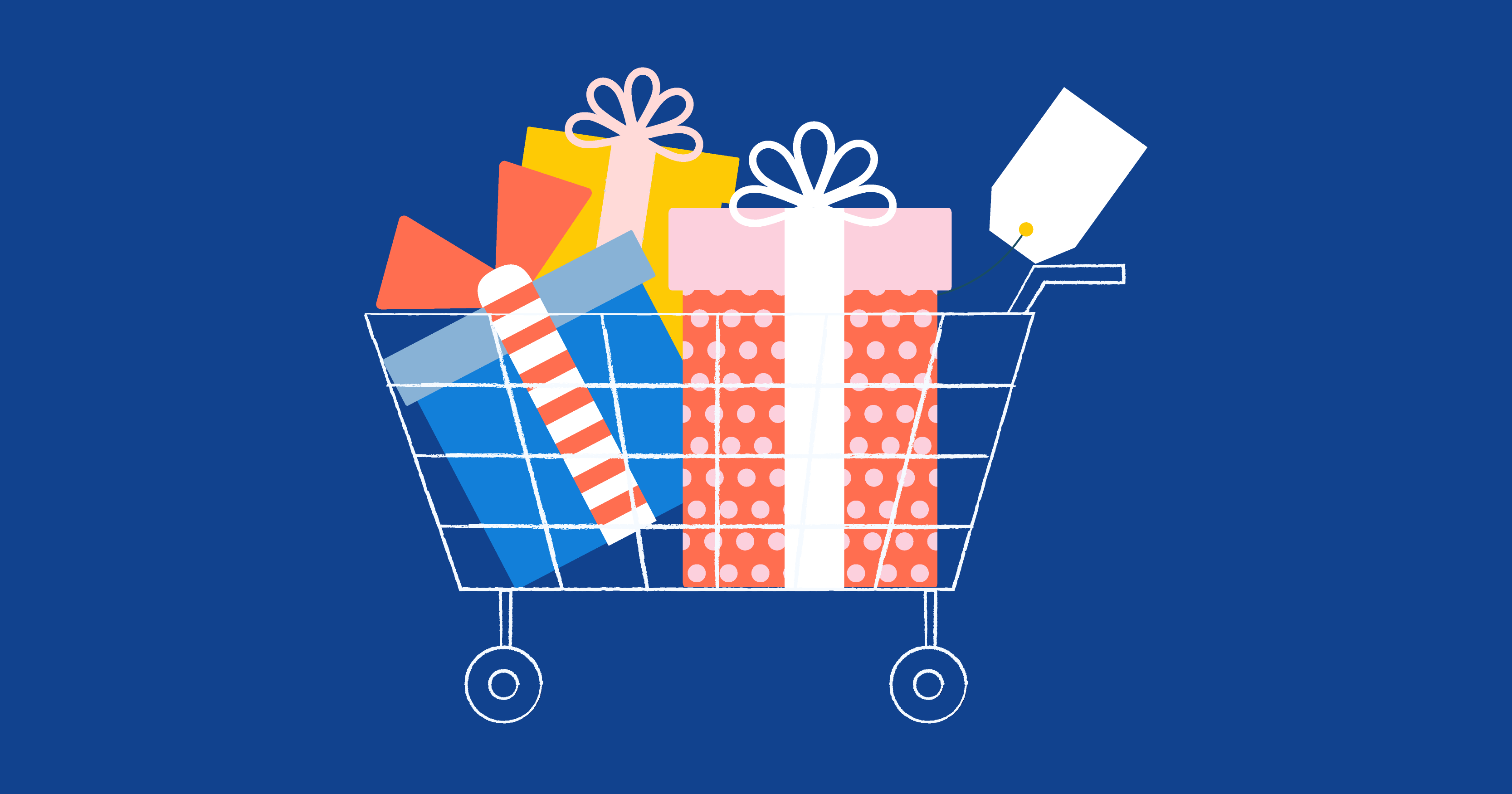
From books to beauty products, if you’ve recently made an online purchase, you’re in good company—global e-commerce revenue is expected to reach $6.3 trillion in 2023.
The world of online retail lets consumers buy anything from one-time treats to monthly subscriptions from the comfort of their homes. As demand for convenient shopping experiences has skyrocketed over the past decade, millions of digital-native brands have risen to meet the needs of consumers.
But a surprising (and strategic) trend has arrived on the e-commerce scene. Shoppers’ favorite online retailers are popping up in physical locations near them, from e-commerce start-ups to major retail players like Amazon.
Welcome to the hybrid retail revolution. Let’s explore why it’s happening and take a look at seven brands that are setting up brick-and-mortar shops.
From online-only to the best of both worlds
The first instance of e-commerce technically happened in the early 1980s with the Boston Computer Exchange. But it was the arrival of marketplaces like Amazon, eBay, and Etsy—along with online payment solutions—that made online shopping feel as natural as running to the store.
Once shopping from home became second nature for consumers, e-commerce also became a no-brainer for brands big and small. Online-first businesses benefit from major cost savings since they don’t need to purchase or rent a physical storefront or hire customer-facing staff. An online presence also exposes brands to a much larger national or international audience than just those in close proximity to a store.
The debate between e-commerce and physical locations is far from an either-or decision for retailers, though. While digital-only brands remain prevalent, many household names in e-commerce have actually shifted back toward incorporating physical store locations into their strategies, using technology to connect shoppers to their online offerings in-store.
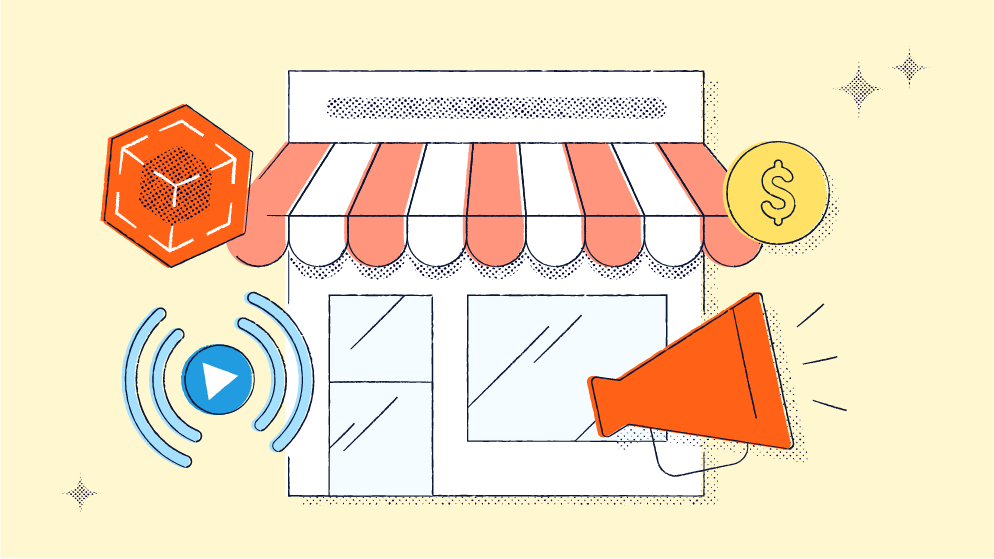
Why hybrid retail wins the day
Online brands may choose to open brick-and-mortar locations for many reasons, from rising customer acquisition costs to the need for greater brand awareness and additional revenue from foot traffic.
The hybrid retail revolution also stems from an overarching trend in the way shoppers engage and connect with brands. Consumers don’t just want multi-channel shopping experiences—they want integrated, omnichannel interactions that connect their online and offline engagement with the brands they love.
With an 88% increase in QR Code creations year-over-year in the Retail industry alone, we’re seeing brands deepen their investment in omnichannel customer experiences through the use of QR Codes on product packaging and throughout retail store locations.
But it’s not enough for customers to be able to buy their favorite products online and in stores. They want both of those experiences to complement each other through:
- Personalized recommendations based on their entire purchase history
- In-store try-on experiences that end with an online purchase
- QR Codes on product packaging that share information about a product or sustainability practices
- A start-to-finish support journey that starts online and ends in-store (or vice versa)
Going hybrid doesn’t just give formerly online-only brands the opportunity to inspire shoppers to buy their products in-store. Expanding from the digital world to in-person is an investment in customer relationships from start to finish.
7 examples of hybrid brands in action
From custom-made suits to sunglasses and sleepwear, plenty of beloved online brands have caught the hybrid retail bug over the past few years. Let’s explore seven businesses that went from crushing it in e-commerce to expanding into brick-and-mortar as well.
1. Warby Parker
Who would’ve thought a glasses retailer would make major waves as an e-commerce trailblazer? Warby Parker co-founder Neil Blumenthal, that’s who! Starting online in 2010, the brand quickly won over loyal fans with glasses and sunglasses frames that were stylish and affordable. Warby Parker’s e-commerce model thrived through offerings like its Home Try-On program. Shoppers could order and test out up to five frames that were shipped straight to them—all for free.
But the brand soon saw the potential for more. Physical retail locations would let Warby Parker offer customers budget-friendly eye exams and, of course, try on more frames in-store to find the perfect pair of specs.
In 2013, Warby Parker’s first brick-and-mortar location in New York City opened its doors to its adoring fans. The eyewear brand even beat tech giants like Google and Amazon to the in-person punch, as both brands had discussed building brick-and-mortar retail outlets at the time. Now, Warby Parker boasts 223 physical stores, and the brand is looking to increase that number to as many as 900 in the years to come.
The key takeaway: If your business is already thriving online, adding physical locations can take that success to the next level through additional service offerings and enhanced hands-on selection experiences.
2. Everlane
Today’s consumers are more eager than ever for transparency and ethical practices from fashion retailers, and brands are now adapting to those demands. But Everlane has been upfront with customers since day one.
The clothing and accessories brand began as an online retailer and set itself apart with its strong sustainability stance. Everlane boasts “radical transparency,” works with ethical factories, and tells customers the story of every product—building trust along the way.
As recently as 2013, the company’s founder and CEO was adamant that Everlane wouldn’t open physical locations, but the brand soon changed its tune. Everlane started by hosting seasonal pop-ups—featuring gifts for the holidays and new category items—but as of 2023, the brand has expanded and opened 10 Everlane boutique locations.
The in-person Everlane experience allows the brand to further its transparency efforts and enhance customer connections at every touchpoint. Shoppers can try on items in real-time, which complements the e-commerce journey the brand is known for. They can buy if they’re ready at the moment or shop later while on-the-go as many items remain available online.
Everlane also offers an enhanced fitting room experience—if there’s a wait, shoppers give an employee their phone number or email to be notified when their turn comes. Everlane can then use that data to better understand its audience and later send personalized SMS messages to its already-loyal fans.
The key takeaway: For online brands that people love, brick-and-mortar locations offer a new channel to tell their brand story and collect customer data.
3. Mejuri
What happens when you combine generations of luxury jewelry expertise with the desire to modernize the jewelry shopping experience? You get direct-to-consumer jewelry brand, Mejuri. CEO Noura Sakkijha originally wanted to depart from traditional jewelry-buying experiences that featured locked cases and pieces displayed on black velvet. Her goal was to shift the perception of fine jewelry purchases and encourage shoppers to buy pieces for themselves.
After beginning this fine jewelry revolution as an online direct-to-consumer retailer in 2013, Mejuri leadership noticed customers’ desire to see and try on pieces for themselves in person. In 2018, they opened the first of 26 showroom locations.
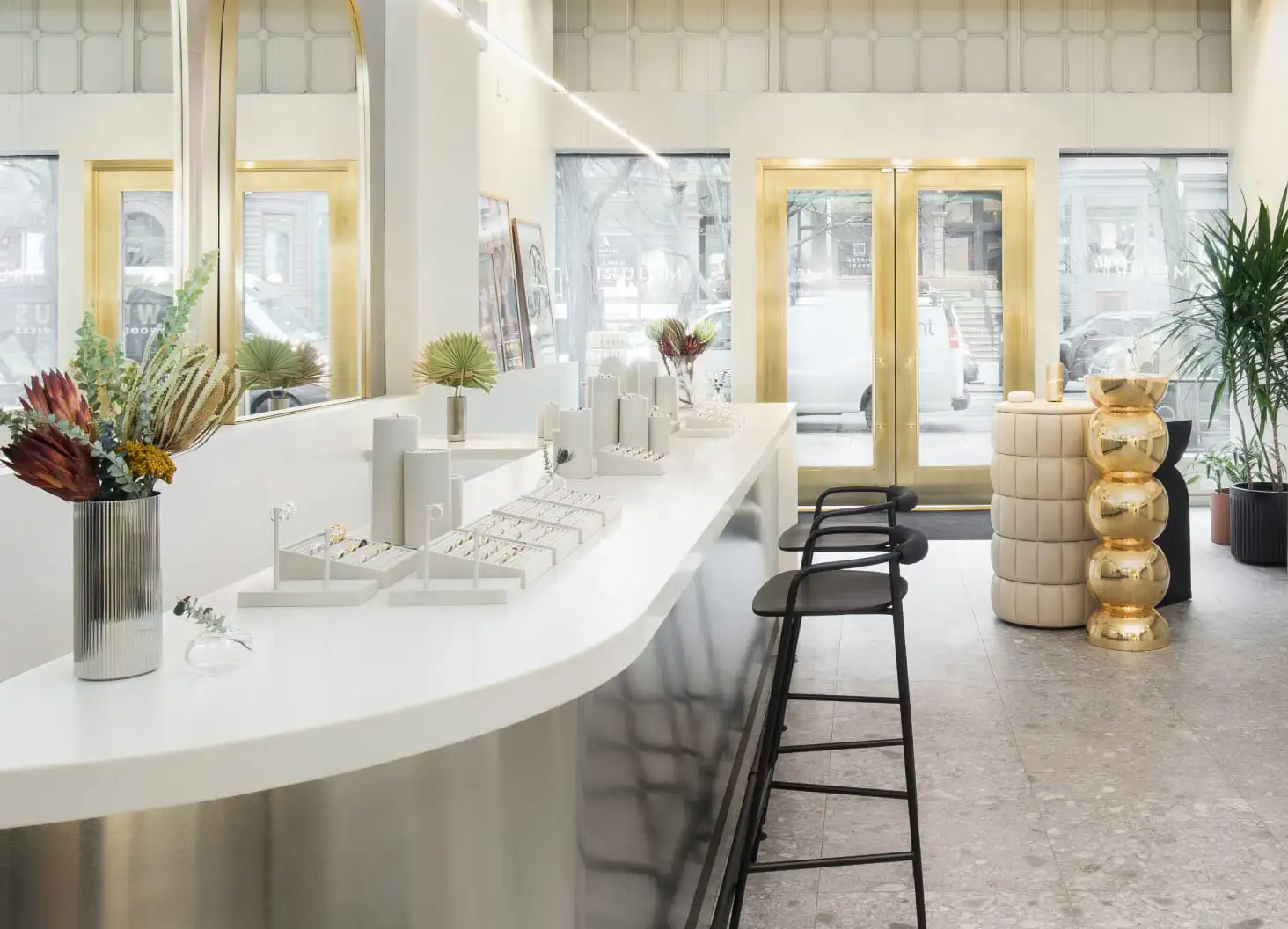
In stores, customers experience jewelry pieces for themselves. They enjoy a more personal, engaging, and interactive journey at the physical locations, where they can also connect with other customers in the Mejuri community.
The decision to become a hybrid brand translated to greater revenue for Mejuri, too. The brand has seen average order volume increase by 17% in-person over digital purchases and notes that the brick-and-mortar stores have been a strong acquisition channel and loyalty driver.
The key takeaway: A move from digital-only experiences to hybrid offerings fosters deeper customer connections. It can also make way for major industry disruption that serves your customers and your business.
4. Rad Power Bikes
Since 2015, Seattle-based Rad Power Bikes has been pedaling its way to becoming the leading electric bicycle company in North America. The brand started out as a direct-to-consumer online retailer, sparking a loyal network of buyers who shared the company’s passion for sustainability and reducing cars in communities. Through Rad Mobile, customers could access an extensive mobile van network that offered tune-up services with a mechanic and delivery of fully assembled e-bikes.
Over the past several years, Rad Power Bikes pivoted to manage costs and double down on the customer experience, so the brand decided to expand its presence to physical locations across the U.S. and Canada. The shift led the company to shut down its Rad Mobile services.
But brick-and-mortar locations allow Rad Power Bikes to serve customer needs even more effectively through test rides, e-bike service and support, and hands-on exploration of products. They focus on convenience in every interaction—customers can scan Bitly QR Codes in stores to schedule services, book bikes, or preorder upcoming offerings.
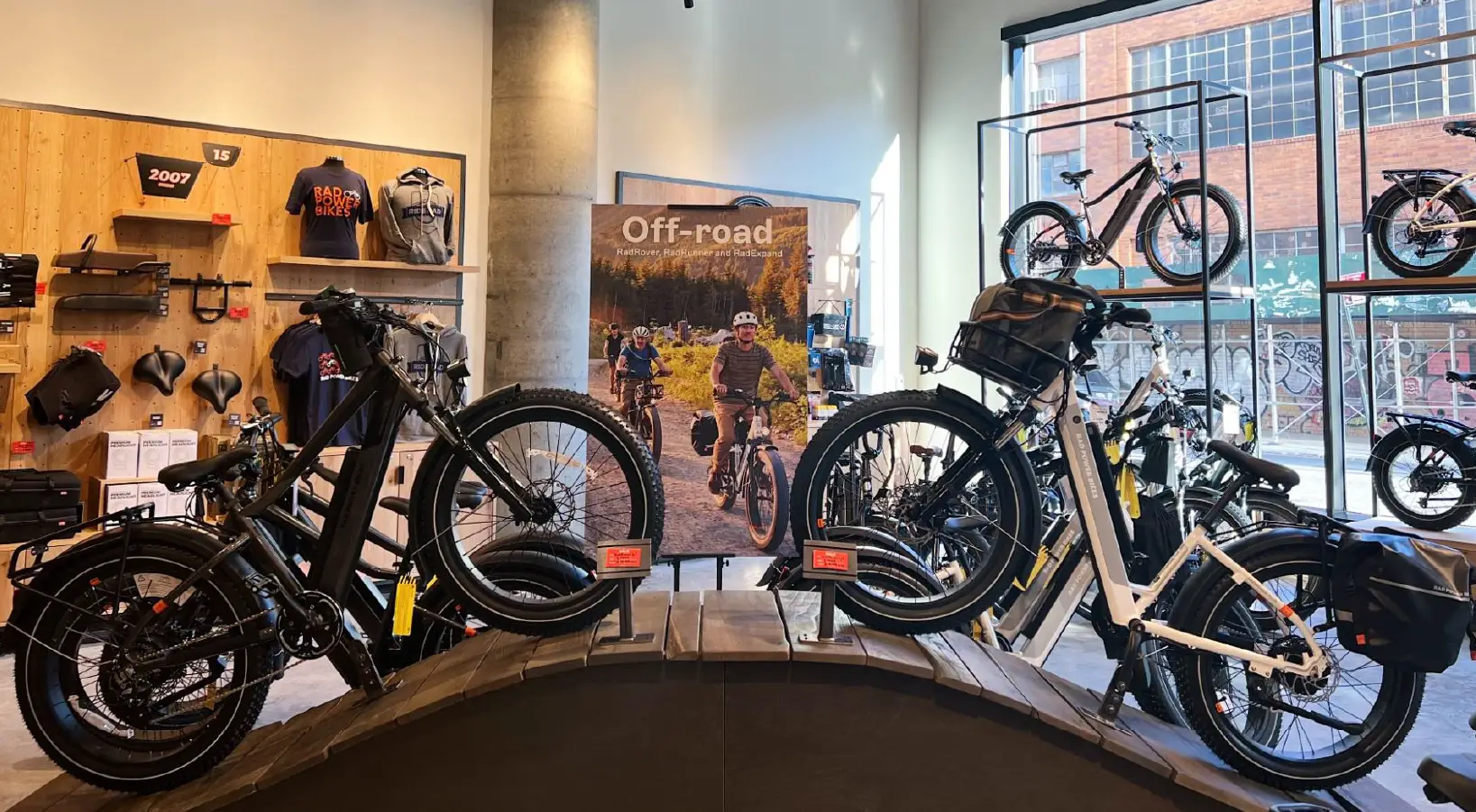
Rad Power Bikes will continue opening physical locations to serve local communities and offer the immersive and personal connections that only face-to-face interactions with customers can provide.
The key takeaway: For brands that sell experiential products like e-bikes, brick-and-mortar locations provide a needed hands-on connection before and after buying—and can even streamline costs for a more sustainable business model.
5. Casper
Companies that miss out on expanding their online brand to in-person experiences are asleep at the wheel. Luckily, Casper isn’t.
Casper went viral for its online mattress-in-a-box model back in 2014, determined to shake up an industry ruled by big-box retailers. By 2018, the company announced plans to open 200 stores, after a handful of pop-up locations in markets like New York City and San Francisco exceeded expectations.
For investments like mattresses—where most people spend around a third of their lives—making the right purchase is essential. The physical stores, called “Casper Sleep Shops,” let customers test out mattresses and experience the brand’s other sleep products firsthand.
Casper’s transition to brick-and-mortar stores was a strategic choice to drive sales both offline and online. The locations draw foot traffic that drives greater awareness with potential customers who may buy Casper products in-store or digitally. The act of physically browsing products also increases opportunities for impulse buys.
The key takeaway: Opening strategic brick-and-mortar locations can be a bid for greater audience education and exposure that lets smaller players and start-ups achieve the needed scale to compete.
6. Allbirds
For sustainable footwear brand Allbirds, going hybrid was a step in the right direction. Inspired by the revolutionary idea of a wool fabric made for shoes—relying on Mother Nature over synthetic alternatives—Allbirds launched as an online retailer in 2014.
From the beginning, sustainability was a core value for the brand and a differentiator for its customers. The brand made the move into brick-and-mortar stores, not only to allow shoppers to try on their eco-friendly kicks, but also to share more about Allbirds’ commitment to sustainability.
The displays in-store reflect a focus on the materials used in Allbirds shoes, including sugarcane, eucalyptus tree fiber, and its signature merino wool. Individual item displays share details about the carbon footprint behind the production of each shoe. The brick-and-mortar stores also reflect their local community—one Chicago location sold limited items like shoe laces, pins, and tote bags inspired by local museums and wildlife.
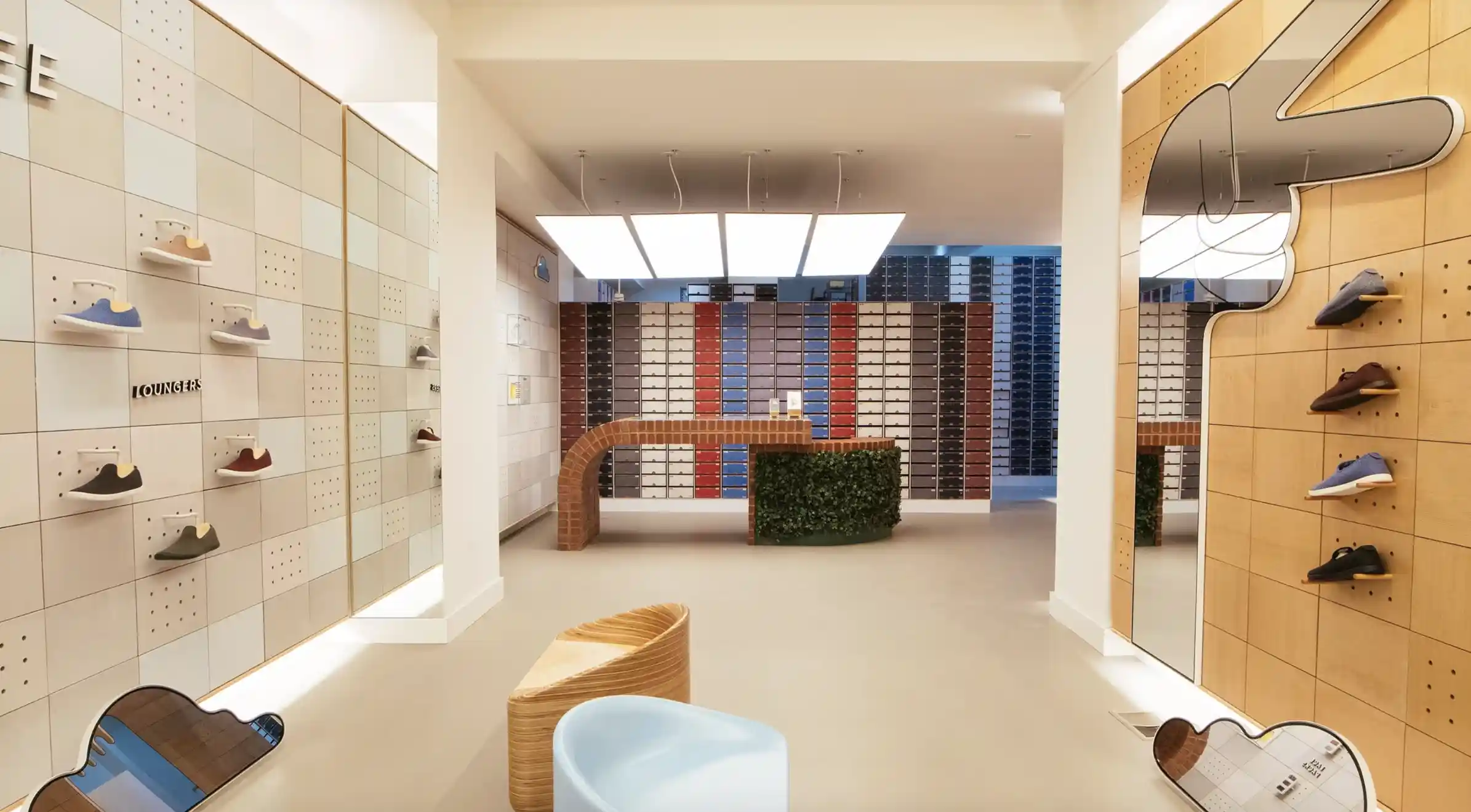
Allbirds has also seen in-person growth through partnerships, like its pop-up events hosted in Nordstrom, where they showcased five new shoe colors.
As Allbirds continues to open new stores alongside its digital offerings, one thing is clear: The omnichannel experience is critical for retaining customers. In 2021, omnichannel repeat customers spent 1.5 times as much as single-channel repeat customers. For hybrid brands like Allbirds, online and offline experiences need to work together for the best possible customer journey.
The key takeaway: An in-person experience with your online brand gives you a chance for greater transparency and immersive brand interactions your customers can’t stay away from.
7. Indochino
When it comes to custom-made clothing for individual consumers, a personal touch can make all the difference. Indochino, the premier made-to-measure clothing brand has been crafting custom suits since 2007—without charging customers a fortune.
Indochino invites customers to “step into the shoes of a designer.” Through the brand’s e-commerce platform, customers provide their measurements and preferences to receive custom wardrobe pieces. Naturally, such an individualized process (and product) lent itself to a more hands-on and interactive experience.
In 2015, the brand began opening in-person showrooms and now calls 86 locations home. Indochino also partnered with Nordstrom to open 21 “shop in shops” nationwide for additional brand reach with Nordstrom customers.
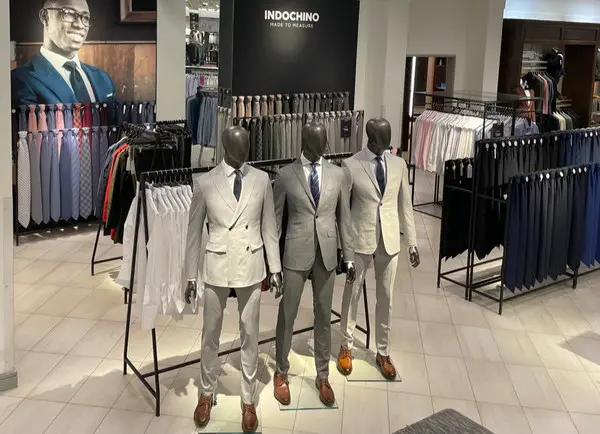
Customers book an appointment to visit their local Indochino location. When they arrive, they’re paired with a Style Guide who takes measurements, helps with fabric selection, and shares custom wardrobe offerings. From start to finish, shoppers enjoy a completely personalized experience that ends with completely personalized garments, too. The showrooms work hand in hand with the brand’s online offerings—customers access their online profiles to review their purchases and conveniently reorder in the future.
The key takeaway: Brands that make items to order can collect all the information they need through online channels, but face-to-face connections take a custom-made customer journey to the next level.
The power of face-to-face connections
Whether your customers stop by a brick-and-mortar location to take a product for a test spin, enjoy an immersive experience, or buy a local exclusive, offline experiences add depth to their interactions with your brand. Time spent with shoppers in-person deepens relationships in ways that an online-only model likely couldn’t capture.
Plus, you get the benefits of digital and face-to-face interactions, and you can bridge the two experiences with tools like QR Codes throughout your stores. With a simple scan, your customers can jump right back into an online experience with you while they’re still shopping in person.
Use every available channel—both online and offline—to turn one-time transactions into lasting connections. From there, your customer’s business, and most importantly, their loyalty will be yours for the taking.
With the Bitly Connections Platform, customers can shorten and customize links, create QR Codes, curate their Bitly Link-in-bio, and track performance all from one place. Feeling inspired? Get started today.